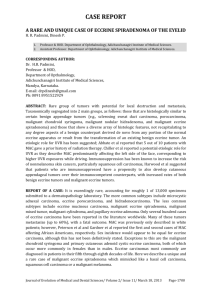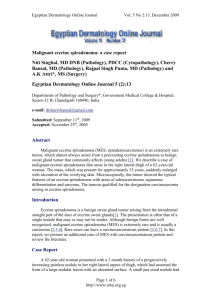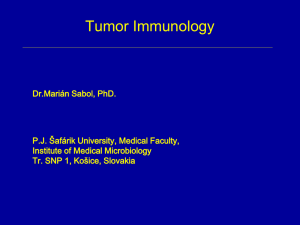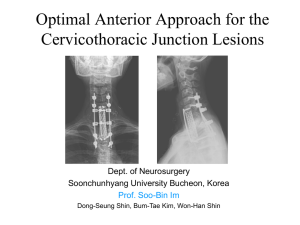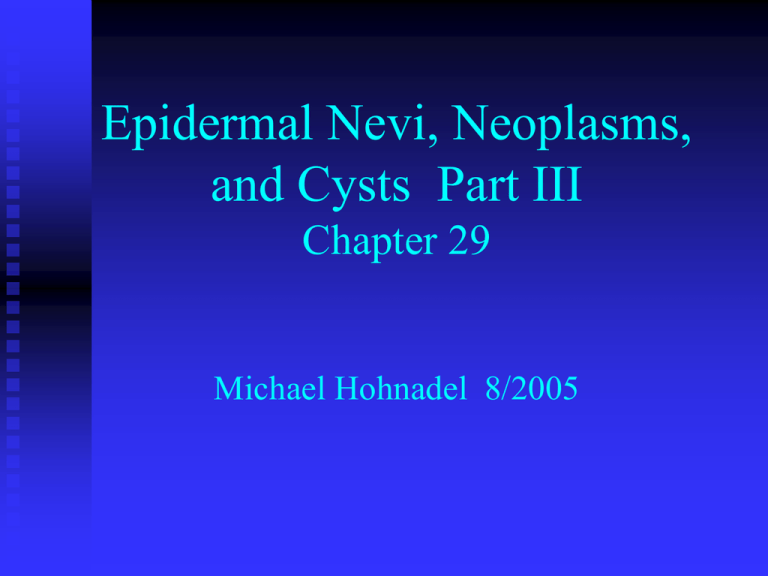
Epidermal Nevi, Neoplasms,
and Cysts Part III
Chapter 29
Michael Hohnadel 8/2005
Syringoma
Small translucent papule
Commonly on eyelids or upper cheeks. Also
may occur on: Axilla, abdomen, forehead,
penis, vulva.
Develop slowly and persist indefinitely
18% of adults with Down’s syndrome
Dilated cystic sweat ducts.
Clear cell variant assoc with DM.
Treatment: Electrodessication, Laser ablation
cryotherapy.
Syringoma
Dilated sweat ducts
with tadpole
appearance.
Eruptive
syringoma
Numerous lesions on the neck, chest, axilla, upper arms and
periumbilically. May resemble LP or 2nd Syphilis as well as
reticulated papillomatosis of Gougerot-Carteaud.
Young persons.
Histologically identical to solitary.
Reported in Down’s syndrome
Clinically may be confused with reticulated papillomatosis of
Gougerot-Carteaud
Eccrine hidrocystomas
Translucent papules
1-3mm which may
have a bluish tint.
Occur on the face.
Usually solitary,
however, multiple
lesions may be seen
May become more
prominent in hot
weather.
Treatment – excision
Topical atropine or
scopolamine
Eccrine hidrocystomas
Cyst cavity lined by double of of cuboidal cells.
Eccrine poroma
Benign, slow-growing, slightly protruding,
sessile, soft, reddish tumor
Most commonly occur on the sole or the
side of the foot. May occur anywhere.
Bleeds with slight trauma
Frequent cup-shaped shallow depression
from which the tumor grows
Benign – simple excision
Eccrine poromatosis
Eccrine poroma
Eccrine poroma
Eccrine poroma, scan power view. Note numerous
epidermal connections by the tumor and the degree
of acanthosis.
Eccrine poroma
Low power view of above showing the vascular
stroma and relatively uniform cell population.
Eccrine poroma
High power view of the small kertinocyte
population having distinct cytoplasmic
borders.
Malignant eccrine poroma
(porocarcinoma)
Most arise from
longstanding eccrine
poromas (50%)
Clinically similar
May also manifest as a
blue or black nodule,
plaque or ulcerated
tumor
M=F, avg 70 yrs.
Distribution: Legs 30%,
feet 20%, face 12%,
thighs 8%
If metastatic, 70%
mortality
Mohs is TOC
Malignant eccrine poroma
There are sharply demarcated nests of tumor within the
epidermis. There is rim of normal epidermal keratinocytes
in most areas
Malignant eccrine poroma
Atypia is prominent. There are no transitional atypical cells
blending with the peripheral normal keratinocytes.
Chondroid Syringoma and
Malignant Chondroid Syringoma
Chondroid Syringoma Malig. Chon. Syringoma
1.
2.
3.
Firm intradermal or
subcutaneous nodule,
most commonly located
on the nose or cheeks
80 % involving the head
and neck
Felt to be of eccrine
origin
1.
2.
3.
4.
Malignant mixed tumor of the
skin
Most occur on extremities.
Reported on face, scalp, back,
buttocks
Grow rapidly. Metastasis more
the 50%
Aggressive surgical excision,
Adjuvant radiation therapy
w/wo chemotherapy
Chondroid Syringoma
Chondroid Syringoma
(mixed tumor of the skin)
Scanning power view of a sharply demarcated subcutaneous
tumor. There are tubular foci, a cystic area and a solid
component.
Chondroid
Syringoma
A medium power view
showing tubular
differentiation.
Clear cell hidradenoma
(nodular hidradenoma)
Classified as an
eccrine sweat gland
tumor
Flesh colored or
reddish, nodular
protruding mass. May
be solid or cystic.
Location: Anywhere.
Most common site is
the head
20% c/o pain on pressure
Multiple lesions reported
Women 2x > men
Extirpation is TOC
Clear cell hidradenoma
(nodular hidradenoma)
Clear cell hidradenoma
(nodular hidradenoma)
Scan power view. Note: epidermal connections are not
usually present. Circumscribed nodular architecture.
Clear cell hidradenoma
(nodular hidradenoma)
High power view. The luminal cells have some apocrine features.
Some of the epithelial cells have clear cytoplasm (glycogen) and
some do not.
Clear cell hidradenoma
(nodular hidradenoma)
Arrows point to some of the mucus producing cells.
Malignant clear cell hidradenoma
(hidradenocarcinoma)
Extremely rare
Presents as a solitary nodule
Lower extremity 32.9 %, upper extremity
27.6 %, trunk 11.9 %, head 26.3 %
Metastasis occurs 60%
Tx wide local excision, radiation and
chemotherapy
Eccrine spiradenoma
Solitary, 1cm, deep-seated
nodule. Most frequently
seen on the ventral
surface.
Skin-colored, blue or pink
with normal overlying
skin.
Paroxysmal pain
Especially upper half
of the body
Multiple lesions, linear
pattern may be seen
Eccrine spiradenoma
Benign clinical course
TX: Simple excision
DDX may include:
A - angiolipoma
N - neuroma
G - glomus tumor
E
L – leiomyoma
Eccrine spiradenoma
Spiradenoma composed intertwining cords of light
and dark cells having no visible cytoplasmic junctions.
Malignant eccrine spiradenoma
In long standing
lesions malignant
degeneration may
occur and my be
lethal. Malignant
Eccrine Spiradenoma
Papillary eccrine adenoma
Uncommon benign lesion.
Dermal nodules, most common on
extremities of black patients.
Tendency to recur.
Treatment: Complete surgical excision
Papillary eccrine
adenoma
Note the papillary intraluminal projections These and the
long tubules help to differentiate this from a syringoma..
Eccrine
syringofibroadenoma
Most presentations are a
solitary, hyperkeratotic
nodule or plaque
involving the extremities
Characteristic marker of
Schopf syndrome
Hydrocystomas of the
eyelids, hypotrichosis,
hypodontia, and nail
abnormalities
cylindroma
Other names: Dermal eccrine cylindroma, Spiegler’s
tumor, turban tumor, and tomato tumor.
Pinkish to blue, solitary (usually), firm rubbery
nodule on scalp or face.
Women chiefly affected
Slow growing. Rarely undergo malignant
degeneration
Treatment :excision
cylindroma
Dominantly inherited form:
1. Numerous rounded
masses of various sizes on
the scalp
2. Appears soon after
puberty
3. Resembles bunches of
grapes or small tomatoes
cylindroma
•Well fit jigsaw
pattern.
•Round aggregates of
eosinophilic material
(arrow)
Sweat gland carcinoma
Mucinous eccrine carcinoma
Eccrine carcinoma
1.
Commonly a round, elevated,
1.
No characteristic
reddish, and sometimes
clinical appearance
ulcerated mass
2.
High incidence of
2.
Usually head and neck (75%)
metastatic spread
3.
Slow growth, asymptomatic
4.
5.
11% incidence of metastasis
Local excision
Aggressive digital
papillary adenocarcinoma
Aggressive malignancy involving the digit
between the nail bed and the distal
interphalangeal joint spaces in most cases.
Presents as a solitary nodule
50% recurrence rate. 50% metastasis.
All patients should have CXR
Complete excision TOC
Amputation may be required.
Microcystic Adnexal Carcinoma
(sclerosing sweat duct carcinoma)
A very slow-growing plaque or nodule.
Occurs most commonly on the upper lip of
women. Central face.
Perineural infiltration is common and may
be extensive
TOC Mohs.
No reports of metastases
Microcystic adnexal carcinoma
Microcystic adnexal carcinoma
1.
2.
3.
4.
Poorly circumscribed.
Ducts.
Tumor islands
*deeper than wide*
APOCRINE GLANDS
ceruminoma
Rare apoeccrine tumor that rarely becomes
malignant
Firm nodular mass in the EAC
Ulceration and crusting may occur
Obstruction if large.
Questionable true entity
Treatment - excision
Hidradenoma papilliferum
Benign solitary tumor
Almost exclusively on
the vulva
Bleeding, ulceration,
discharge, itching and
pain
Firm nodule
excision
Syringadenoma papilliferum
(syringocystadenoma papilliferum)
Most commonly
develops in a nevus
sebaceous of
Jadassohn
Scalp or face
Firm rose red papules
in groups, with
vesicle-like inclusions.
May simulate MC
Transition to
carcinoma is rare
Excision is advised
Syringoma papilliferum
Syringoma
papilliferum
•Irreg. tubules lined by
double cell layer with
decapitation secretion.
•Plasma cells in stroma
Apocrine hidrocystoma/cystadenoma
(apocrine retention cyst)
Solitary, dome-shaped,
smooth-surfaced
translucent nodule.
Bluish or brownish.
Benign tumor
Occurs chiefly on the
face. Penile shaftmedian raphe cyst.
TX: Simple excision
Apocrine hidrocystoma
Large cystic spaces. Decapitation secretion
Apocrine hidrocystoma
A high power view of the linings of two of the cysts. A few
brown, lipofuchsin pigment granules (PG) are in the basilar part
of the epithelium. Apocrine snouts are prominent.
Apocrine gland carcinoma
Rare
Axilla is the most common site
May be seen in the nipple, vulva and EAC
May originate from aberrant mammary
glands
Widespread metastases may occur
HAIR FOLLICLE NEVI AND
TUMORS
Pilomatricoma
(calcifying epithelioma of Malherbe)
Asymptomatic, solitary, deeply seated firm nodule,
covered with normal or pink skin.
Stretching may show “tent sign”
Most commonly on the face, neck or arms
Derived from hair matrix cells
Clinical DDX is impossible
TX: Simple excision
Familial patterns do occur
Multiple in Rubinstein-Taybi and Gardner
syndrome
Malignant variety exist. Rare. Not aggressive.
pilomatricoma
pilomatricoma
Well circumscribed. Basophilic and eosinophic areas in continuity.
pilomatricoma
Crowded basophilic cells
blend into eosinophilic
‘ghost cells’
Ghost cells
Trichofolliculoma
Benign, highly
structured adenoma of
the pilosebaceous unit
Small dome-shaped
nodule on the face or
scalp
A small wisp of fine,
immature hairs
protrude from a
central pore
Simple excisional bx
Multiple follicles opening on central cystic space
Trichoepithelioma
(epithelioma adenoides cysticum, multiple
familial trichoepitheliomas)
Occur as multiple cystic and
solid nodules typically on the
face.
Nodules are small,
rounded, smooth, shiny,
slightly translucent and
firm.
Flesh colored or slightly
reddish
Slightly depressed center
Often grouped and
symmetrical
Benign
Solitary trichoepithelioma
Nonhereditary
Mostly on face
Giant solitary
trichoepithelioma
May reach several cm
Mostly on thigh and
perianal
Desmoplastic
trichoepithelioma
Difficult to
differentiate from
morphea-like BCC
Solitary or multiple on
the face
trichoepithelioma
The tumor is composed of lobules
with anastomosing streaks of
uniform basaloid cells congregated
in immature hair cell structures
without atypia, all surrounded by
a fibromyxoid stroma.
trichoblastoma
Benign neoplasms of follicular germinative
cells
Asymptomatic
Scalp and face.
Surgical excision
Tend to ‘shell out’
Trichilemmoma and Cowden’s disease
(multiple hamartoma syndrome)
Benign neoplasm of
outer root sheath of
the hair follicle
Small solitary papule
on the face, esp nose
and cheeks.
Multiple lesions are a
marker for Cowden’s
syndrome.
Cowden’s syndrome
87% of patients with
Cowden’s develop
tricholemmomas.
38% develop
malignancies
Breast 25-36%
Thyroid 7%
Colon
adenocarcinoma
Tumor suppressor gene
Trichilemmoma
Oriented about a hair folicle. Varying degrees of clear cell
differentiation. May have palisading. No mucin helps differentiate
from BCC.
Trichilemmal carcinoma
Sun exposed areas
Face and ears
Slow growing
epidermal papule,
indurated plaque or
nodule with tendency
to ulcerate
Surgical excision
Trichodiscoma
and fibrofolliculoma
Trichodiscoma
Hundreds of flat or
dome-shaped, 2-4 mm
skin-colored
asymptomatic papules
occuring on face,
trunk and extremities.
Autosomal dominant
trait
Controversial entity
Fibrofoliculoma
2-4 mm. Solitary,
more commonly
multiple.
Scattered over the
face, trunk and
extremities
Birt – Hogg – Dube
syn.
Renal CA. assoc.
Abdominal CT.
Slits in collagen
Proliferating
trichilemmal cyst
Large exophytic
neoplasms
Almost exclusively
confined to scalp and
back of neck
May ulcerate
Assoc. with nevus
sebaceous
Metastasis may occur
Most respond to surgical
excision
Dermoid cyst
Congenital in origin
Chiefly along lines of
cleavage
Result from improper
embryologic development
Potential for intracranial
communication
CT or MRI scan is required
to rule this out prior to BX
over cranial cleavage
planes
Freely mobile and not
attached to the skin
Pilonidal cyst
Midline hairy patch or pit in the sacral
region with a sinus orifice in the bottom, or
a cyst beneath it
Usually becomes symptomatic during
adolescence
Treatment: Opening cyst widely, debriding
it, and packing it with silver nitrate crystals
SCC has been reported to arise from chronic
inflammatory pilonidal disease
Pilonidal sinus
Steatocystoma simplex
Noninheritable
counterpart to the
more familiar
steatocystoma
multiplex
Face limbs or chest
Simple excision
Steatocystoma multiplex
Multiple, small, yellowish, cystic nodules 2-6 mm
in diameter.
Contain a syrup-like, yellowish, odorless oily
material
Principally on the upper anterior trunk, upper
arms, axillae and thighs
Lesions may be generalized
High familial tendency hence likely an autosomal
dominant inheritance.
Tx- excision of individual lesions
Incision and expression or aspiration
Steatocystoma multiplex
Steatocystoma
•Corrugated cyst wall.
•Cyst wall with
mature sebaceous
lobules
Eruptive vellus
hair cysts
Yellowish to reddish
brown, small papules
of the chest and
proximal extremities
Autosomal dominant
inheritance
Disseminated lesions
reported
Milia
White keratinous cysts, 1-4 mm
Chiefly on the face esp under eyes
May occur in great numbers
Occur in up to 50 % of newborns
Primarily develop without a predisposing
condition
Can develop in inflammatory conditions and skin
diseases such as epidermolysis bullosa,
pemphigus, bullous pemphigoid, PCT, herpes
zoster, contact dermatitis, and after prolonged use
of NSAIDS
milia
Variants include MEM (multiple eruptive
milia)
May be familial. AD
MEP (milia en plaque) – many milia, post
auricular.
Tx
incision and expression
Tretinoin and minocycline for MEP
milia
Pseudocyst of the auricle
Fluctuant, tense, noninflammatory swelling
of the upper ear
Believed to be assoc. with trauma
Tx – drainage
Intralesional steroids
Cutaneous columnar cysts
Four types of cyst that occur in the skin are
lined by columnar epithelium
1.) Branchiogenic cyst
Small solitary lesions just above the
sternal notch
2.) Thyroglossal duct cysts
Anterior aspect of the neck
Malignancies reported 1%
Cutaneous columnar cysts
3.) Cutaneous ciliated cysts
Usually located on the legs of females
Perineum vulva and foot regions
4.) Median raphe cyst
Developmental defects lying in the
ventral midline of the penis, usually on
the glans
Surgical intervention is standard therapy
The End

